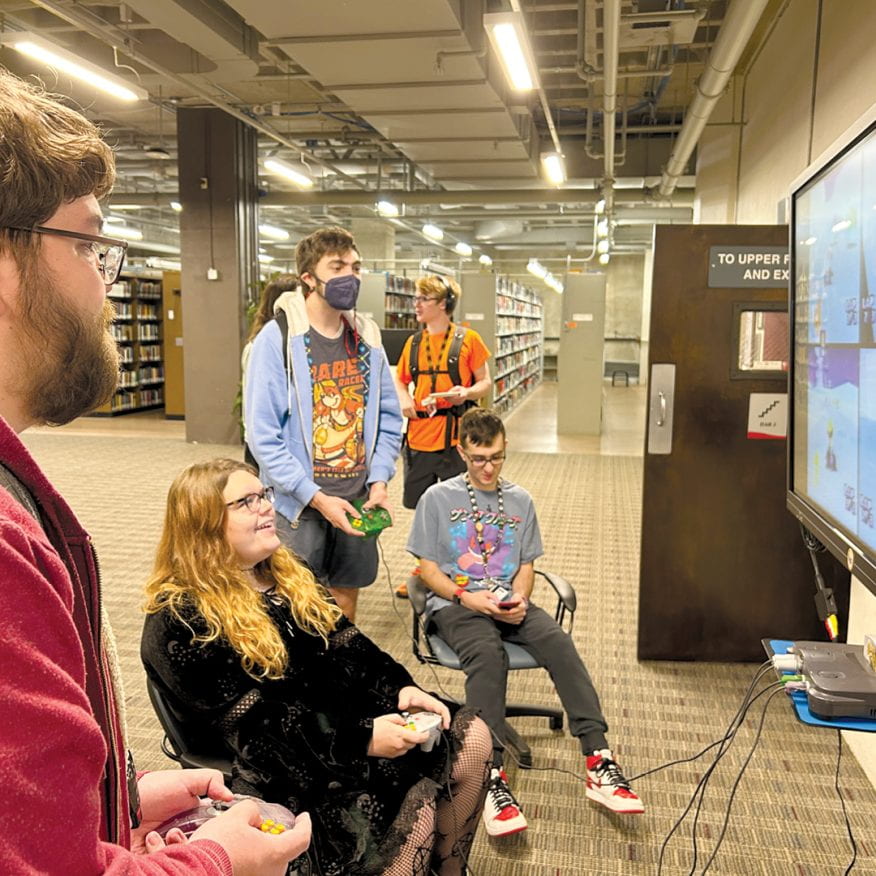The Archivist: A Game Plan for Success
Looking back at the first two decades of Interactive Media and Game Design.
Read StoryIt’s not often you hear the fun and bouncy sound of Super Mario Bros. theme music in a library. But the recognizable soundtrack to the retro video game and the exclamations from excited game enthusiasts permeated the ground floor of George C. Gordon Library last October.
On this evening, the entrance to WPI’s Archives and Special Collections was filled with dozens of students, faculty, and staff. They huddled in groups around four television sets to play classic video games like Pac-Man, Mario Kart, and Zelda and watch others test their skills on game consoles dating back four decades, all items preserved in WPI’s collection.
The buzzy scene was the kickoff event for the newest exhibit of Archives and Special Collections, “Video Game Console Wars, 1976-2001, featuring WPI’s Interactive Media Archive & Interactive Media and Game Development Department.” The exhibit, located in the library’s Gladwin Gallery, features a display of consoles including a 1970s Atari 2600, the Mattel Electronics Intellivision, a Nintendo Entertainment System from 1985, and a 1995 Sony PlayStation. The exhibit also includes vintage system controllers and games such as Frogger and Metroid.
The collection on display was built through collaborations between Archives and Special Collections and IMGD program faculty and staff. One of the program’s founding professors, the late Dean O’Donnell, was a driving force in gathering and preserving the historical items. Arthur Carlson, university archivist and assistant director for the library, says the exhibit reflects a core mission of Archives and Special Collections, “to support WPI’s unique educational model. One of the ways we do that is by documenting both the history and development of academic courses and providing access to unique resources.”

Carlson says the archive of video games and interactive media is rare among colleges and universities. The collection places WPI with the likes of The Strong National Museum of Play and the Smithsonian, which developed a video game archive in 2016.
The exhibit will be on display until August 2024. It’s one in a series of displays at the Gladwin Gallery that showcase WPI history and culture. Exhibit organizers expect other events throughout the academic year, including more opportunities for students to play the vintage consoles.
A stroll through the exhibit takes you down a nostalgic video game memory lane on one wall. And on the opposite wall, you travel back to the present, guided by snapshots of IMGD history, including WPI Journal coverage of IMGD’s launch in 2004 as the nation’s first such degree-granting program, the original degree proposal, information on the program’s special events, and game and interactive media projects led by students and faculty. Among the projects highlighted are Neurotype Café, a video game designed to depict the everyday experiences of neurodivergent people; the Worcester Art Museum Augmented Reality Jewelry Try-On, a mobile app that lets visitors “wear” pieces from the “Jewels of the Nile” exhibit; and WHEEL UP, a virtual reality wheelchair training simulator.
“I think the exhibit is a good reminder that if you’re a student here, everything you do while you’re here is something that contributes to WPI’s future history,” says Gillian Smith, director of IMGD and associate professor. She points out that the broader video game industry is building upon history, with some of the decades-old game titles and systems featured in the archives being used today in artificial intelligence research. “I’m excited for our students to be able to experience being able to look at this really rich history of games and think about how we design technology today and how we will design it far into the future.”

Looking back at the first two decades of Interactive Media and Game Design.
Read Story
Reader Comments
0 Comments